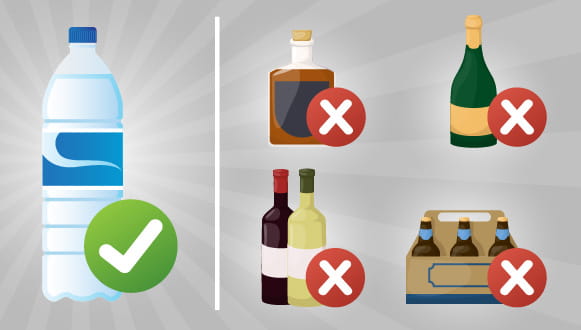Is Dry January Actually Good for You?

According to everything we see on social media, there's no better time for "self-improvement" than the month of January. New year, new you — am I right?
In fact, those first 31 days of each year seem to be when we are most gung-ho about actually doing all of the things we know improve our mental and physical health. You know the ones: Exercise more. Eat healthier. Watch TV less. Drink less...
Drinking less, in particular, is an easy target. Not only do you know that drinking in excess is unhealthy, but many of us spend the last chunk of each year — aka, holiday season — drinking more than usual.
So, this new year, you may be considering an alcohol detox by way of what the Internet calls "Dry January" — a health trend where you go straight from ringing in the new year with a glass of bubbly to abstaining from alcohol for the rest of the month.
But does Dry January actually work?
"When it comes to alcohol, drinking in moderation is key. I always encourage people to know the recommended limit of alcohol and to drink within these limits," says Dr. Joshua Septimus, associate professor of clinical medicine and medical director of Houston Methodist Primary Care Group Same Day Clinics.
And while an alcohol detox may seem like just what you need after waking up from a New Year's Eve party, Dr. Septimus says that the benefit of limiting your alcohol intake is more complicated than having a "dry" January.
How does Dry January affect your body?
Before we get into the weeds of how Dry January might benefit you, we need to talk about how alcohol itself affects your body.
You're probably well aware of both the immediate and short-term effects of alcohol. After having a few drinks, you've been known to buy a thing or two off Instagram or dig into that bag of junk food sitting in your pantry (*cough* lowered inhibitions). In some cases, you may notice vision changes, loss of coordination and mood swings. After a night of drinking comes the hangover — complete with one or more (or all) of the following: headache, nausea, fatigue, irritability and sensitivity to light and sounds.
"In the short-term, especially if your drinking is marked by excessive consumption, you may even be at risk for blacking out, which can be incredibly dangerous," warns Dr. Septimus. "Then there are the long-term effects of alcohol, where we see damage to organs throughout your body."
In particular, long-term excessive alcohol consumption increases your risk of:
- Cirrhosis of the liver
- Cancer, particularly breast cancer and esophageal cancer
- Heart failure
- High blood pressure
With the long-terms effects of alcohol, in particular, it's easy to see how your body might benefit from some time off.
But, is an alcohol detox as simple as Dry January?
"Alcohol is one of the most toxic substances for your liver, but your liver is also one of the few organs that can regenerate itself — given the right environment," explains Dr. Septimus. "Taking a month away from alcohol can certainly provide a healing environment for your liver. But, the question quickly becomes: What about after Jan. 31?"
What happens after Dry January?
"Avoiding alcohol can help your liver heal. But if you follow up Dry January by drinking excessively on Feb. 1, you're not doing yourself (or your liver) any favors," warns Dr. Septimus. "The reason I don't particularly like the idea of a Dry January is because it implies a feast-or-famine mentality when it comes to alcohol, which isn't safe."
Instead of Dry January, Dr. Septimus recommends knowing how much alcohol is too much and limiting your alcohol intake accordingly — more often than not, more years than not.
- Men should drink no more than two servings of alcohol per day
- Women should drink no more than one serving of alcohol per day
"It should be added that a serving of alcohol is not a large glass of wine filled to the brim. And if you're drinking a craft beer or an IPA, which often have a higher alcohol content than traditional beer, limiting yourself to a serving of alcohol may mean drinking less than a full can," adds Dr. Septimus.
A serving of alcohol looks like:
- 5 oz. of wine
- 12 oz. of a standard beer
- 1.5 oz. shot of liquor
By: Katie McCallum

















